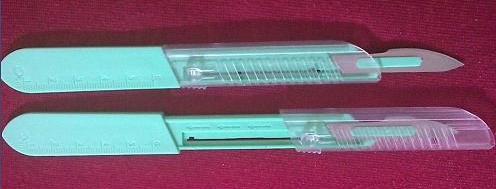The “Elective Slide”
March 13, 2018By: Adeline Yi, Anzen™ Product Manager
Which is better: a retractable blade or retractable sheath? Surgeons weigh in.
One of the key functions of any safety scalpel is to cover the blade when it’s not in use. This can be accomplished in one of two ways.
Some safety scalpels cartridges are designed with sliding shield — a plastic sheath that moves forward or backward to either cover or expose the blade. Other safety scalpels employ a sliding blade that retracts into the cartridge, much like the mechanism of a box cutter. Which do surgeons prefer?
New research shows that surgeons prefer a sliding blade design. Here’s why:
- The sliding blade movement is more familiar and intuitive to surgeons, since most have had experience using box cutters
- The blade can be extended or retracted with the thumb while keeping a firm grip on the handle. Because there’s no need to adjust one’s grip, the user is less likely to drop or fumble with the device while covering or uncovering the blade
- The “activation distance”—the distance the thumb must travel to slide the blade—is shorter than the activation distance of a sliding shield
In the past, sliding blade designs were thought to be less stable, as the moving blade could wobble. But the new Anzen™ scalpel avoids blade wobble with a design that locks the blade into place, and also prevents it from retracting during stabbing incisions.

The Anzen™ Safety Scalpel (moving blade design) in open and closed positions

Disposable scalpel with a moving shield design. Source
Surgeons’ preference for the Anzen™ design was validated during interviews at ACS 2017, where 63 surgeons were asked to compare a safety scalpel with a moving shield to the Anzen safety scalpel (with a retractable blade.)
In those interviews, 82.5% of the surgeons reported that the Anzen™ scalpel was easier and more intuitive to use than a sliding-shield model.
MediPurpose has designed the Anzen™ scalpel to make the use of safety scalpels more comfortable and familiar to surgeons, so that they can convert to the use of a safety scalpel with confidence.


